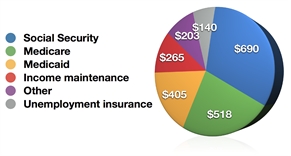Looking Backward and Forward on Entitlement Programs
Last year”s presidential elections, along with the more recent fiscal cliff and debt ceiling negotiations, have put the spotlight on our nation”s tax policy, deficit, and entitlement programs. For some, entitlement programs are necessary–a social compact for America in an era of longer life spans, the decline of employer-provided pensions and health insurance in retirement, and a widening gap between the haves and the have-nots. For others, the current level of entitlement spending is jeopardizing our country”s fiscal health and creating an “entitlement lifestyle.” No matter where you stand in the debate, do you know the basic facts on our country”s largest entitlement programs?
Where the money goes
All entitlement spending isn”t created equal. The “Big Three” of Social Security, Medicare, and Medicaid account for more than two-thirds of all federal entitlement spending. Social Security and Medicare are primarily age-based programs, whereas Medicaid is based on income level. According to the U.S. Bureau of Economic Analysis, in 2010, the federal government spent a total of $2.2 trillion on entitlement programs, with the Big Three accounting for $1.6 trillion of this total. The largest expenditure was for Social Security ($690 billion), followed by Medicare ($518 billion) and Medicaid ($405 billion).
A history of growth
Alexis de Tocqueville, the famous French political thinker who traveled to the United States in the early 1830s and wrote about the uniqueness of our young nation”s individual self-reliance in his famous book, Democracy in America, would likely be surprised to observe the growth in spending on entitlement programs that has occurred in online casino the United States over the past 50 years. According to the Bureau of Economic Analysis, in 1960, U.S. government transfers to individuals totaled about $24 billion in current dollars. By 2010, that figure was $2.2 trillion, almost 100 times as much.
Current status
Let”s look at our two main entitlement programs–Social Security and Medicare.
Social Security. Created in 1935, Social Security is a “pay-as-you-go” system, meaning that payments to current retirees come primarily from payments into the system by current wage earners in the form of a 12.4% Social Security payroll tax (6.2% each from employee and employer). These payroll taxes are put into two Social Security Trust Funds, which also earn interest. According to projections by the Social Security Administration, the trust funds will continue to show net growth until 2022, after which, without increases in the payroll tax or cuts in benefits, fund assets are projected to decrease each year until they are fully depleted in 2033. At that time, it”s estimated that payroll taxes would only be able to cover approximately 75% of program obligations.
Medicare. Created in 1965, Medicare is a national health insurance program available to all Americans age 65 and older, regardless of income or medical history. It consists of Part A (hospital care) and Part B (outpatient care)–which together make up “traditional” Medicare; Part C (Medicare Advantage, which is private insurance partly paid by the government); and Part D (outpatient prescription drugs through private plans only). Medicare Part A is primarily funded by a 2.9% Medicare payroll tax (1.45% each from employee and employer), which in 2013 is increased by 0.9% for employees with incomes above $200,000 (single filers) or $250,000 (married filing jointly). In addition, starting in 2013, a new 3.8% Medicare contribution tax on the net investment income of high-earning taxpayers will take effect.
Looking ahead, Medicare and Medicaid are expected to face the most serious financial challenges, due primarily to increasing enrollment. The Congressional Budget Office, in its report Budget and Economic Outlook: Fiscal Years 2012 to 2022, predicts that federal spending on Medicare will exceed $1 trillion by 2022, while federal spending on Medicaid will reach $605 billion (state spending for Medicaid is also expected to increase). According to the CBO, reining in the costs of Medicare and Medicaid over the coming years will be the central long-term challenge in setting federal fiscal policy.
Reform
There has been little national consensus by policymakers on how to deal with rising entitlement costs. At some point, though, reform is inevitable. That”s why it”s a good idea to make sure your financial plan offers enough flexibility to accommodate an uncertain future.
An unsustainable path
The bipartisan Bowles/Simpson Deficit Reduction Commission stated that “our nation is on an unsustainable fiscal path” in regard to entitlement spending.

